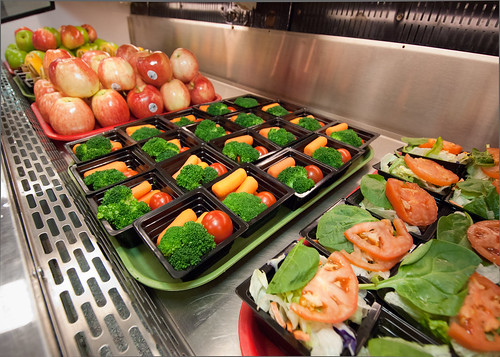
October was National Farm to School Month and at FNS we ended on a high note. We released our very first nationwide assessment of farm to school activities and there was a lot of good news to be shared. The Farm to School Census showed that adoption of farm to school activities is trending up; many schools that do not currently have farm to school programs are planning to start them, and millions of children are being exposed to healthy foods and learning about where food comes from. In fact, in school year 2011-2012, schools invested over $350 Million in locally produced, healthy food. This adds up to major benefits for American nutrition and local economies.
But the benefits don’t stop there. In addition to creating new market opportunities for farmers and producers across the country, farm to school programs are a way to get students familiar with healthy foods so that they don’t throw those items away when they end up on their cafeteria tray.
USDA has teamed up with the Environmental Protection Agency to get the word out about how important reduction of food waste is in our homes, businesses, and everywhere food is consumed or served – including schools. One of our concerns is that students sometimes discard food because they aren’t familiar with the item or the taste. This is of particular concern when it comes to fruits and veggies—two items young children need to consume more of. We’ve worked with schools to address the issue of waste using many approaches including raising the standards for the quality of foods offered and served in cafeterias across the country in accordance with the Healthy Hunger-Free Kids Act.
Farm to school activities can provide another long term solution to help reduce food waste by helping kids get familiar with a variety of fruits and veggies very early on. Farm to school programs expose children to lessons about healthy eating and give them hands on experience with agriculture through school gardens and through integration of local foods into school menus. Essentially, farm to school programs help healthy habits take root. Research shows that children in schools with school garden programs eat more fruits and vegetables and are more willing to try new, healthy foods—positive steps in the right direction in the fight against childhood obesity and plate waste.
Just last week, we announced additional support for schools to buy local. USDA awarded 71 grants, spanning 42 states and the District of Columbia, to connect school cafeterias with local farmers and ranchers through its Farm to School program. Farm to School Month may have come to a close, but our support of farm to school efforts and the many benefits they bring to communities, agriculture, and our environment continues on. For more information on USDA’s partnership with the Environmental Protection Agency to reduce food waste, please visit http://www.usda.gov/oce/foodwaste. To view Farm to School Census results, please visit http://www.fns.usda.gov/farmtoschool/census.
